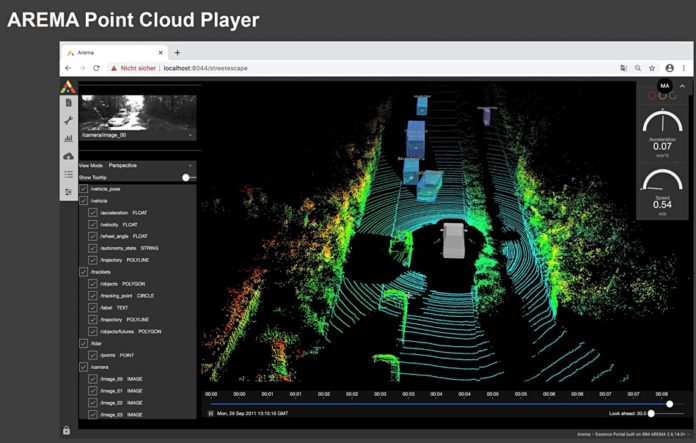This week we have have panned more nuggets and fragments of gold from the storage news stream. It features automated driving systems, Kubernetes container data protection, media workflow storage, Oracle supporting RoCE and Optane, Amazon Web Services partnering, technology patent awards and more, from ReRAM to data warehousing via edge computing right out to DNA-based malware.
The amount of what we might call weekly background news in the storage industry is getting steadily larger. Scan this bulletin and see for yourself.
IBM AREMA and ADAS
IBM Archive and Essence Manager (AREMA) orchestrates any file-based broadcast production workflow and is used in Autonomous SDRiving (AD) and Automated Driver Assistance Systems (ADAS). AREMA is a media asset management system, and has more than 140 different, ready-to-deploy agents and new workflows can be swiftly modified or created. Each agent interacts with the workflow engine and executes one specific functionality — such as actual functionality in file transfers or adapters to control third-party systems. “AREMA for Automotive” was introduced about four years ago on a project by project base and it’s now becoming a standard IBM Software product.

We’re told AREMA is the “clue” software which is needed by the automotive engineers to find the needle in the haystack data snippets to be used for AI training for Level 4/5 robo cars. AREMA works with Spectrum Scale, NAS filers and any S3 Object Storage, all at the same time. OpenShift/K8 is also supported.
You can ask questions like: “Please find all data in the data lake where the temperature was >5 degrees, the road was wet, speed 40–60km/h and yellow buses with flashing lights were involved”. It will find all relevant files and timings and works with video, radar and LiDAR data.
Catalogic crams more into CloudCasa
Cloud-native data protector Catalogic has added more features to its CloudCasa product. This provides scalable data protection, with a free service tier, and disaster recovery service for cloud-native apps, and supports all leading Kubernetes distributions and managed services and cloud database services.
CloudCasa now supports backup of Kubernetes persistent volumes (PVs) to cloud storage including Amazon Elastic Block Storage (EBS) persistent volumes and is offered in a new capacity-based subscription model. The PVs get:
- Fair, capacity-based pricing for persistent volume backups — Users pay only for the data being protected vs what infrastructure is in use.
- Free Service Tier — Unlimited PV and Amazon RDS snapshots with up to 30 days’ retention, with no limits on worker nodes or clusters, and Kubernetes resource data included.
- Free Amazon RDS snapshot management — Multi-region copies with no limits on databases or accounts.
- Software and storage included — as a SaaS application, there are no software costs, no storage to purchase, no infrastructure to provision.
- Security and compliance — SafeLock protection provides tamper-proof backups that are locked from deletion by any user action or API call.
Oracle Exadata X9M, Optane and RoCE
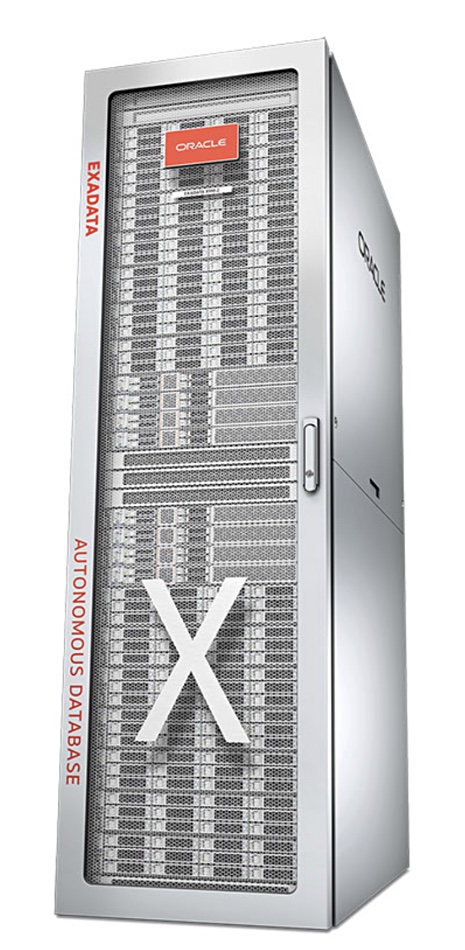
Database and ERP supplier Oracle announced the availability of its Exadata X9M prouducts, converged systems to run Oracle Database. They include the Exadata Database Machine X9M and Exadata Cloud@Customer X9M, which runs Oracle Autonomous Database in customer datacentres. It supports small databases running with fractional CPUs to enable agile, low-cost consolidation, application development, and testing.
Oracle says they deliver higher performance at the same price as the previous generation. They accelerate online transaction processing (OLTP) with more than 70 per cent higher IOPS rates and IO latencies of under 19 microseconds. They also deliver up to an 87 per cent increase in analytic SQL throughput and machine learning workloads.
This enables customers to reduce the costs of running transactional workloads by up to 42 per cent, and analytics workloads by up to 47 per cent.
Juan Loaiza, EVP Mission-Critical Database Technologies at Oracle, said: “For X9M we adopted the latest CPUs, networking, and storage hardware, and optimized our software to deliver dramatically faster performance. Customers get the fastest OLTP, the fastest analytics and the best consolidation — all at the same price as the previous generation. No other platform, do-it-yourself infrastructure, database, or cloud service comes close to Exadata X9M performance, cost/performance, or simplicity.”
The X9M systems use Intel’s latest Xeon SP processors and support Optane persistent memory and RDMA over Converged Ethernet (RoCE). They have 33 per cent more database server CPUs and memory, as well as 28 per cent more storage than previous generations.
Oracle says that, compared to Amazon RDS using all-flash storage, Exadata Cloud@Customer X9M delivers 50x better OLTP latency. Compared to Microsoft Azure SQL using all-flash storage, Exadata Cloud@Customer X9M delivers 100x better OLTP latency. For analytics, Exadata Cloud@Customer X9M delivers up to 25x faster throughput than Microsoft Azure SQL, and up to 72x faster throughput than Amazon RDS. Exadata Cloud@Customer X9M also delivers 50x better OLTP latency and 18x more aggregate throughput than databases running on AWS RDS using a full rack AWS Outposts configuration.
DNA-based malware
A Wired article discusses a demonstration of DNA-based malware:
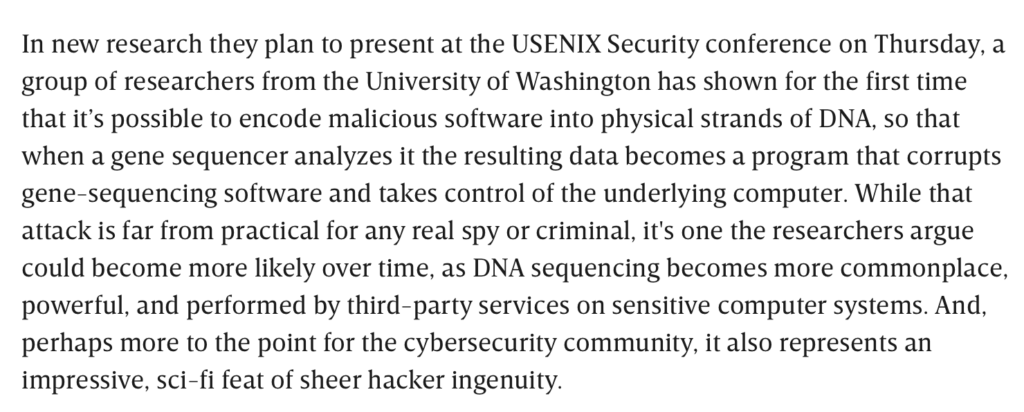
Read the article and enjoy the ingenuity of it all.
Symply’s new product range for digital media professionals
Media-centric shared storage supplier Symply has launched its SymplyFIRST product range with personal RAID protected storage, backup/archive, cloud archive/transfer, and connectivity features for media pipelines in on-set production, post production, VFX, and for independent filmmakers, in-house creatives, photographers, and other media professionals.
SymplyPRO LTO and SymplyPRO DIT are Thunderbolt 3-connected desktop and rack systems with LTO-9 tape with up to 18TB native storage per tape and over 400Mbits/s read/write speed. Systems are available in multiple configurations including a cable-less design, all-metal enclosure that allows for fast removal and insert of tape drives for transport or upgrade. SymplyPRO LTO systems are certified for use with popular backup and archive utilities for macOS and Windows including YoYotta, Hedge Canister, and Archiware P5.
SymplyATOM (Advanced Tape Operations and Management) software is included with every SymplyPRO LTO system.
SymplyPRO DIT is an archive and transfer system with multi-access technology combining camera card readers for RED, Atomos and Blackmagic Design along with removable 2.5″ SSD and LTO tape for fast all-in-one DIT storage operations.
SymplySPARK is a personal transportable media-optimized RAID system with quiet operation, Thunderbolt 3 connectivity and capacities up to 144TB. Its impact-resistant flight-friendly carry case features tool-free user serviceability of drives, fans, and power supplies.
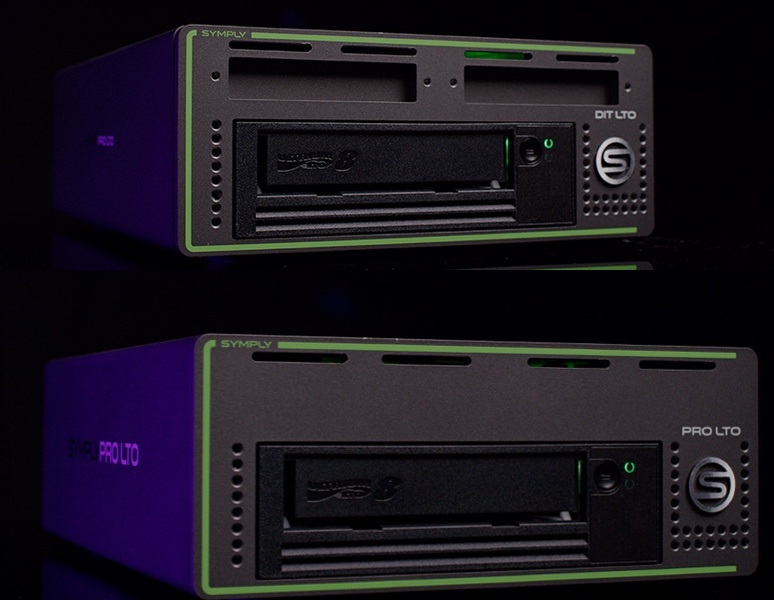
SymplyNEBULA is a cloud backup and archive with S3 compatibility with datacentres throughout the US and Europe and no egress charges. It is available for a single per-TB price and is up to ten times faster than other providers. It enables easy movement of content to and from AWS EC2 for a variety of media processing and compute functions.
SymplyADDR is a series of affordable high-performance PCIe expansion slot systems.
SymplyLOCK is a simple Thunderbolt cable lock that works with all SymplyFIRST products and any Apple-certified Thunderbolt cable preventing accidental disconnection of a Thunderbolt device.
SymplyFIRST products are now generally available from resellers worldwide. Prices range from:
- $4,599 USD for SymplyPRO LTO (thunderbolt connected tape drive);
- $3,299 USD for SymplyLTO (SAS connected tape drive);
- $4,199 USD for SymplySPARK (thunderbolt connected eight bay storage);
- $4.99 USD per month for SymplyNEBULA.
WANdisco replicates loss
Replicator WANdisco has seen revenues fall six per cent year-on-year. Its first half 2021 revenues of $3.4 million compare to the $3.6 million earned a year ago. Back in September 2020 we wrote that this UK company is heavily loss-making and the revenue picture is muddied as it transitions from selling perpetual licences to subscription. However, it is buoyed by a recent capital raise of £25 million and on the back of strong demand for its Azure software “expects to deliver significant revenue growth in FY2021 with the Board expecting a minimum revenue of $35 million.”
We now hear that the General Availability of its Azure service is expected in the next few weeks, “a critical step in converting pipeline customers.” You don’t say. Its statutory loss from operations has risen to $20.3 million from the $14.0 million reported a year ago. Also WANdisco has reduced its full year revenue target from $35 million to a minimum of $18 million. That is still an ambitious 71 per cent increase on the $5.2 million 2020 revenue amount.
The company has raised $42.4 million through a share placing and subscription to accelerate its growth ambitions and pursue near-term opportunities with channel partners. It has won a contract with the analytics division of a global telco to migrate analytical data to the Microsoft Azure cloud, worth a minimum of $1 million over a maximum term of five years.
The problem for WANdisco is that its ability to transfer bits from source to target is not matched by its ability to transfer dollars from customers to its own bank account.
Amazon Web Services
Chinese American distributed OLAP startup Kyligence, originator of Apache Kylin and developer of the AI-augmented data services and management platform Kyligence Cloud, has been accepted into the Amazon Web Services (AWS) Independent Software Vendor (ISV) Accelerate Program, a co-sell program for AWS Partners who provide software solutions that run on or integrate with AWS.
File data lifecycle manager Komprise announced a special offer with Amazon Web Services (AWS) to attendees of the AWS D.C. Summit, taking place September 28 and 29. AWS Summit attendees could get a risk-free assessment of their data savings from Komprise, and be eligible to receive up to 25 per cent off their estimated first year AWS spend if they convert within 90 days.
Cloud file storage supplier Nasuni is working with AWS to address ransomware in the public sector with three new offerings designed to deliver extremely fast ransomware file recovery, as well as built-in backup and disaster recovery, all at a reduced price. These new bundles are available for a limited time as Ransomware “First Aid Kits” for Public Sector Files in AWS. The Nasuni Ransomware First Aid Kits for Public Sector can be procured in AWS Marketplace, while also leveraging AWS Consulting Partners like CDW-G, SHI Government, Presidio and AHEAD.
Patents
Cloud-native storage startup Robin.io has been awarded nine new US patents in the first nine months of 2021. They boost the company’s IP portfolio in three technologies central to the management and orchestration of 5G and enterprise cloud-native applications with Kubernetes. The patents are:
- Orchestration of heterogeneous multi-role applications (#11086725).
- Rolling back Kubernetes applications (#11113158).
- Reducing READ loads on cloned snapshots (#11099937).
- Automated management of bundled applications (#11036439).
- Automated management of bundled applications (#10908848).
- Redo log for append-only storage scheme (#11023328).
- Block map cache (#10976938).
- Implementing secure communication in a distributed computing system (#10896102).
- Health monitoring of automatically deployed and managed network pipelines (#11108638).
Ionir, which supplies storage and data services for Kubernetes-orchestrated containers, has been awarded a US patent for its system of synchronising data containers and improving data mobility. It says its patent allows application data to move with the ease of applications. This data mobility ensures the application can start working immediately at the new location. Full volumes — regardless of size or amount of data — are transported across clouds or across the world in less than 40 seconds. The company owns ten issued patents in this field and has submitted applications for many more.
Shorts
Backblaze says it offers instant recovery in any cloud through its use of Veeam Backup and Replication. Its “Backblaze Instant Recovery in Any Cloud [is] an infrastructure as code (IaC) package that makes ransomware recovery into a VMware/Hyper-V based cloud easy to plan for and execute for any IT team.” Customers “can use an industry-standard automation tool to run a single command to quickly bring up an orchestrated combination of on-demand servers, firewalls, networking, storage, and other infrastructure in phoenixNAP, drawing data for your VMware/Hyper-V based environment over immediately from Veeam Backup & Replication backups.”
Cloudflare’s R2 Storage zero egress cost takes on egregious S3 egress charges. R2 Storage is a public cloud storage service that is S3-compatible but at a lot lower cost than Amazon’s S3 service. The Register, our sibling publication, covered this last week. Our interest is that there is a growing number of cloud services taking on Amazon’s S3 — witness Backblaze — and we should see S3 price cuts shortly, even if they are nominal.
Red Hat OpenShift containers can read and write object data from Cloudian HyperStore object storage systems. Cloudian supports the Kubernetes CSI (Container Storage Interface)as well as Amazon’s S3 interface and both SSDs and Optane for faster object IO performance. OpenShift containers get API call access, multi-tenancy, support for multiple public cloud (AWS, Azure and GCP) back-end storage, and data encryption.
Enterprise file collaboration supplier Egnyte released its 2021 Data Governance Trends Report, which surveyed 400 IT executives in July 2021. It found that unchecked data growth, combined with a lack of visibility, is increasing the risk of breaches, ransomware, and compliance violations dramatically. The most commonly cited application of AI that companies are currently using or plan to invest in the next 12 months is to identify and protect sensitive data in files (47 per cent). Another 42 per cent are using AI to assess risk and threats, and 40 per cent are using it to monitor for malicious behaviour. (Expect Egnyte to buff up its AI credentials.)
In-memory SW supplier Hazelcast announced GA of its Hazelcast Platform product for transactional, operational and analytical workloads. It combines the capabilities of a real-time stream processing engine with in-memory computing with a robust library of connectors from MongoDB to Redis Labs to Snowflake.
SaaS data protector HYCU has recruited service provider Teraflow to its Cloud Services Provider Program. Teraflow is a data engineering and artificial intelligence firm based in London with offices in Johannesburg, South Africa. Its also recruited Extreme Solution, a Google Cloud partner servicing customers across Egypt, UAE and North America, Extreme Solution is used by millions of users across a number of industries for Mobile and Web Solutions Development, Public Cloud and mission-critical Infrastructure initiatives.
IBM Spectrum Scale container native v5.1 adds:
- Separate operator namespaces;
- Multiple custom resources and controllers;
- Core pods managed by daemon controller;
- Online rolling pod upgrade;
- Set memory and CPU requests and limits for pods;
- Support for storage cluster encryption;
- Automated deployment of CSI Driver;
- Using the GUI;
- Automated IBM Spectrum Scale performance monitoring bridge for Grafana.
NetApp is recruiting more staff. Wells Fargo analyst Aaron Rakers tracks some mainstream storage suppliers’ recruitment trends and a chart of NetApp’s open job positions shows a sustained rise over recent months.
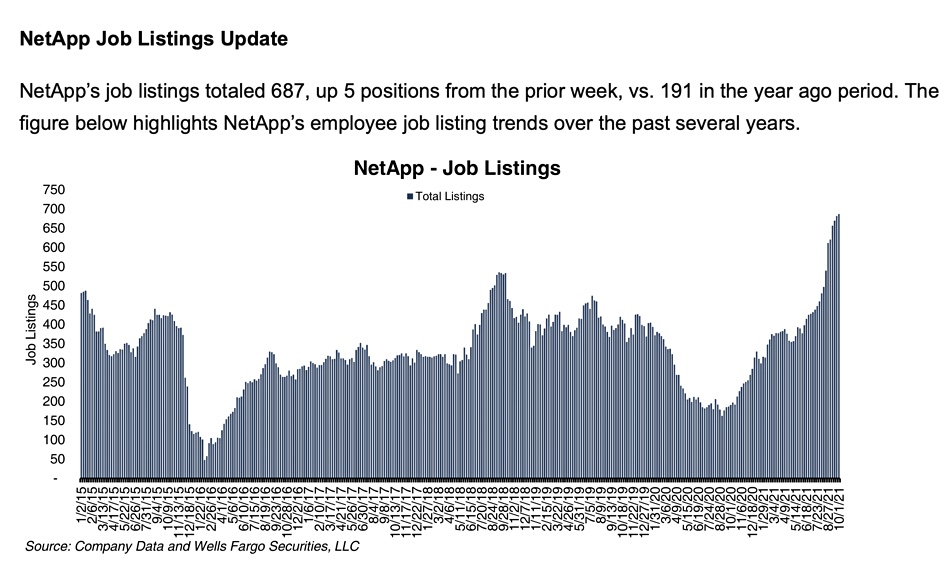
We think this may be to do with its cloud services business unit led by Anthony Lye.
Blast-from-the-past: privately-owned and legacy storage supplier Overland-Tandberg, now separated from Sphere3D, has added RDX SSD drives alongside its RDX HDD line of removable disk drive cartridges. Having removable SSDs in RDX cartridges gives RDX users a faster backup and restore medium. The available capacities are 500GB, 1TB, 2TB, 4TB, and 8TB.
Phison has announced a technology development of PCIe Gen-5 customisable SSD controller products for enterprise and client SSDs. It is actively developing its first PCIe Gen-5 platform — the E26 Series Controller and SSD which will support PCIe Dual Port and have advanced features such as SR-IOV and ZNS, and support for the newest, fastest NAND interfaces ONFI 5.x and Toggle 5.x. The E26 Gen-5 test chip has been successfully taped out in 12nm advanced process, and customised SSD solutions are targeted to be shipping in the second half of 2022.
Managed multi-cloud Kubernetes-as-a-Service provider Platform9 has, during the past 12 months, grown as a company by 50 per cent, quadrupled its customer base and tripled revenue. It’s increased the capacity that Model9 Cloud Data Manager protects by 10 times.
New Zealand-based Portainer launched its Portainer Business Charmed Operator, supporting integration with Canonical’s Charmed Kubernetes distribution. It enables the automatic installation and integration of Portainer Business as part of the Kubernetes cluster deployment process, using Juju, the Charmed Operator framework. Portainer Business transforms any Kubernetes implementation into a containers-as-a-service setup. [See bootnote about used of ‘Charmed’ term.]
IOMesh by Kubernetes storage supplier SmartX has achieved Red Hat OpenShift certification, and is officially available on Red Hat Ecosystem Catalog. Kyle Zhang, CTO & Cofounder of SmartX, said: “The Red Hat certification demonstrates our ability to support mission-critical workloads on OpenShift.”
24Gbit/sec SAS connectivity was highlighted by the the SCSI Trade Association (STA) at the 2021 Storage Developer Conference, a virtual storage industry event sponsored by the Storage Network Industry Association. A SAS Integrator’s Guide, which provides additional detail on the subject, can be downloaded here. See the event agenda here.
The SNIA’s Storage Management Initiative has announced the approved ISO certification for the Swordfish 1.1.0d specification. The SNIA Swordfish specification extends the DMTF Redfish Scalable Platforms Management API specification to define a comprehensive, RESTful API for managing storage and related data services.
Synology announced GA of its new operating system, DSM 7.0.1 for the vast majority of its storage devices, including its enterprise NAS and surveillance-focused offerings. It features expedited processing of support requests through Active Insight integration, Fibre Channel support, flash volume deduplication, and a K8s CSI driver to improve volume management in Kubernetes.
Synology also announced Hybrid Share which enables simple and fast file synchronisation between locations or offices, combining efficient local file caching with bandwidth offloading to the cloud to improve productivity while reducing IT burdens.
Data Warehouse-as-a-Service supplier Vertica has launched its Vertica Accelerator, which runs on the new Vertica 11 Unified Analytics Platform. Vertica Accelerator runs on AWS public cloud infrastructure in a customer’s own AWS account, providing the ability to preserve all negotiated pricing and committed spend while automating the setup and management of the Vertica environment. It includes all of the core functionality — from advanced analytical functions including time series, pattern matching, geospatial, and in-database end-to-end machine learning.
Server virtualiser and containeriser VMware has a blog arguing for the use of computational storage at the edge. It’s to get rid of computational bottlenecks caused by moving data to compute. “Computational storage devices (CSx) enhance the capabilities of traditional storage devices by adding compute functionality that can improve application performance and drive infrastructure efficiency.”

The blog explains: “Instead of moving the data to a central location for processing, we move the processor to the data! By allowing the storage devices to process the raw data locally, CSx (SSDs with embedded compute, like those provided by NGD Systems) are able to reduce the amount of data that needs to be moved around and processed by the main CPU. Pushing analytics and raw data processing to the storage layer frees up the main CPU for other essential and real-time tasks.”
ReRAM developer Weebit Nano has implemented its ReRAM in a 28nm process. This is much denser than the 130nm process with which most of its development work has been done, and a step on from the prior 40nm process. It says this is a key step in productising the technology for the embedded memory market and the technology can support smaller geometries used in AI, autonomous driving, 5G and advanced IoT.
Western Digital says the World Economic Forum (WEF) has named two of its smart factories in Penang, Malaysia and Prachinburi, Thailand to its Global Lighthouse Network, a community of world-leading companies that have demonstrated leadership in the adaptation of Fourth Industrial Revolution at scale in both technology innovation and workforce engagement. Lighthouses apply 4IR technologies such as artificial intelligence, 3D printing and big data analytics to maximise efficiency and competitiveness at scale, transform business models and drive economic growth, while augmenting the workforce, protecting the environment, and contributing to a learning journey for all-sized manufacturers across all geographies and industries.
Zadara’s enterprise-grade, expert-managed cloud services — including compute, storage and networking — are now available to Cyxtera customers. Zadara’s fully managed storage-as-a-service has been available in Cyxtera’s 61 highly connected, hybrid-ready datacentres worldwide. Now Zadara’s zCompute has been added and delivers a seamless on-demand cloud experience available in Cyxtera datacentres, built and managed by Zadara.
People
Victoria Grey has resigned from her role as CMO at Arm server startup Bamboo Systems. Previously she had been CMO at Nexsan and VP Marketing at Quantum as well as a VP at EMC after it bought Legato where she was OEM Sales Manager.
NVMe-oF storage supplier Excelero has hired Jeff Whitaker as its VP of Product. He joins Excelero from NetApp, where he was a founding member of the NetApp cloud team that defined its first cloud-based products. His most recent role was NetApp’s senior manager of hyperscaler portfolio marketing.
HYCU has hired Michele Lynch to be its EMEA Channel Director. She comes via stints at Spirent, Localis, Scality and Commvault.
Panzura CEO Jill Stelfox has been named Transformation Leader of the Year for 2021 in the annual Globee Awards by an international panel of experts. A Panzura spokesperson tells us: “The accolade is based on Jill’s leadership through Panzura’s Refounding process which started with our acquisition last May and officially concluded a few weeks ago.” Among the achievements are a Net Promoter Score of 87, and rocketing past all previous sales records with year-over-year revenue growth of 525 per cent and an ARR of 96 per cent.
Charming Bootnote. Where did the term Charmed Opertator come from? Portainer tells us: “‘Juju was created in 2009 in order to tackle the infrastructure and application management problem, trying to take the solution a step forward from the traditional configuration management tools. Ever since its beginning, Juju used “charms”, wrappers of code to manage infra/app components by encapsulating the knowledge of human operators.
“These two names were employed, because at that time people considered the solution working “like magic”. In recent years, Kubernetes operators have started to make their appearance to solve the same problem within the cloud native ecosystem. Since Kubernetes quickly became a first class citizen in Juju, we decided to slightly rebrand charms into “charmed operators”. The difference between standard Kubernetes operators and charmed operators is the latter’s ability to integrate and drive software lifecycle management across different cloud environments, not only Kubernetes, but also legacy systems, virtualization platforms (e.g. Openstack) and public clouds.”


